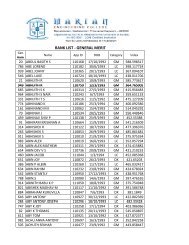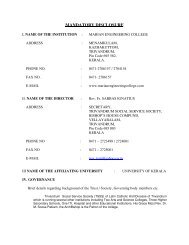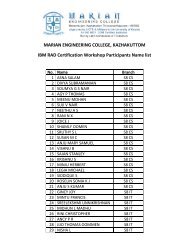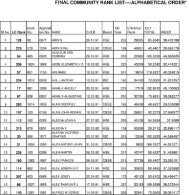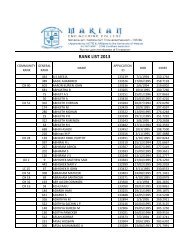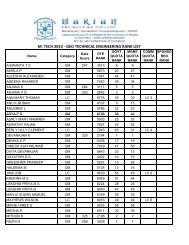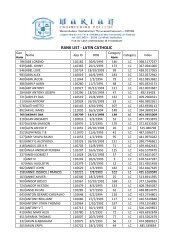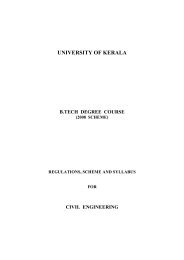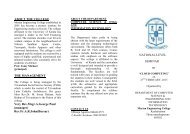UNIVERSITY OF KERALA - Marian Engineering College
UNIVERSITY OF KERALA - Marian Engineering College
UNIVERSITY OF KERALA - Marian Engineering College
Create successful ePaper yourself
Turn your PDF publications into a flip-book with our unique Google optimized e-Paper software.
B.Tech Comp. Sc. & Engg., University of Kerala 69<br />
08.705 (3) NEURAL COMPUTING (ELECTIVE II) 3 – 1 – 0<br />
Module I (18 hours)<br />
Introduction – Brain and Computer – learning in biological systems and machines – the basic neuron –<br />
modeling a single neuron – learning in simple neurons – the perceptron – the perceptron learning rule – proof<br />
– limitations of perceptron – the multilayer perceptron – the multilayer perceptron learning rule – Back<br />
Propagation network – Counter Propagation network.<br />
Module II (16 hours)<br />
Associative memory – introduction – the learning matrix – Hopfield networks – storage and retrieval<br />
algorithms – the energy landscape – Bi-directional associative memory – the Boltzman machine – Boltzman<br />
machine learning algorithm – Radial basis function networks.<br />
Module III (18 hours)<br />
Kohonen self organizing networks – introduction – the Kohonen algorithm – weight training –<br />
neighbourhoods – reducing the neighbourhood – learning vector quantization – the phonetic typewriter –<br />
Adaptive resonance theory (ART) – architecture and operation – ART algorithm – training the ART<br />
network – classification – application of neural networks.<br />
Text Books:<br />
1. Neural Computing: An Introduction – Beale R. and Jackson T., IOP Publishing Ltd/Adam Hilger.<br />
Reference Books:<br />
1. Neural Computing: Theory and practice – Philip D. Wasserman, Van Nostrand Reinhold Co publishing<br />
2. Neural Networks Algorithms, Applications and Programming Techniques – J.A. Freeman and D.M. Skapura,<br />
Addison-Wesley/Pearson Education.<br />
3. Fundamentals of Neural Networks: Architectures, Algorithms, and Applications – L. Fausett,<br />
Prentice Hall Inc./Pearson Education.<br />
4. Artificial Neural networks – B. Yegnanarayana, PHI<br />
5. Neural Networks: A Classroom Approach – S. Kumar, Tata McGraw Hill Publishing Company Ltd.<br />
Internal Continuous Assessment (Maximum Marks-50)<br />
25 Marks - Tests (minimum 2)<br />
15 Marks - Assignments (minimum 3) such as home work, problem solving, literature survey, seminar,<br />
term-project, software exercises, etc.<br />
10 Marks - Regularity in the class<br />
University Examination Pattern<br />
PART A: Short answer questions 10 x 4 marks=40 marks<br />
All questions are compulsory. There should be at least three questions<br />
from each module and not more than four questions from any module.<br />
PART B: Descriptive/Analytical/Problem solving questions 3 x 20 marks=60 marks<br />
Candidates have to answer one question out of two or two questions<br />
out of four from each module<br />
Maximum Total Marks: 100



